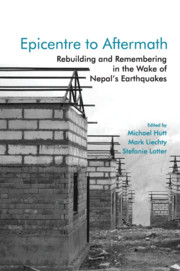13 - Working on Disaster: Nepali Artists' Engagement in Post-Earthquake Kathmandu Valley
Published online by Cambridge University Press: 08 July 2021
Summary
In the aftermath of the 2015 earthquakes in Nepal, local artists were at the forefront of responding to the event through art practice as well as helping those in need. This chapter explores ways in which the disaster produced particular responses from artist-activists based in Kathmandu. In responding to the disaster, they developed strategies and tactics for coping with, and working on, the event and its consequences for people's everyday lives (see Liechty and Hutt, this volume). In this way, a temporal solidaric community emerged, both digitally and through on-site art events that, as Liechty and Hutt (this volume) propose, aimed at rebuilding ‘lives, meaning, memory, and social relations’, thus ‘actively crafting a future’. This crafting, or aesthetic formation (Meyer 2009), could be traced across various levels, from individual initiatives on Facebook to on-site collective curations and exhibitions, including engagements with very particular local concerns and conditions as well as international strategies of artistic relief work (for example, the Tōhoku Earthquake in Japan [2011] from where the art project Camp.Hub in Bhaktapur received inspiration by learning how solidaric relief work helped aged people and tried to use traditional and simple ways of socializing to allow for coping strategies in disaster regions to evolve and nurture social fabrics). One of the key aspirations of the artists whose work I shall discuss in this context was, I propose, to shape moments of bottom-up solidarity that helped earthquake victims to consider themselves as survivors who could generate hope and confidence while also recognizing despair and crisis. The social networks that were thus appealed to were clearly based on the idea of transgressing caste, ethnic, and class boundaries rather than reifying essentialized boundaries. However, they also did so by paying attention to local particularities, such as specific terminologies, preferences and values, and cultural patterns.
This chapter will consider the photographic series ‘Meanwhile in My Neighbourhood: Earthquake Diary’ by the artist Sanjeev Maharjan. This set of several dozen photographs, taken with a mobile phone camera immediately after the 25 April earthquake and uploaded onto the artist's Facebook page, revolves around the dominant presence of the disaster as a media spectacle, against which the artist composes a subtle visual narrative of ‘ordinary’ everyday lives. These images show how the earthquake event intensified an already existing artistic engagement with urban and social transformation that has now, in the dramatic aftermath, developed even further.
- Type
- Chapter
- Information
- Epicentre to AftermathRebuilding and Remembering in the Wake of Nepal's Earthquakes, pp. 308 - 340Publisher: Cambridge University PressPrint publication year: 2021
- 1
- Cited by



